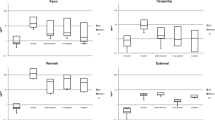Abstract
Objective. To examine if xylenes and xylene isomers in end-of-shift urine are good biological indicators of low-level exposure to each solvent, similarly to toluene in urine.
Methods. The study was conducted in the latter half of a working week. Furniture makers, 86 subjects in total (76 men and ten women), participated in the study in combination with 11 non-exposed subjects. Time-weighted average (8-h TWA) exposures to mixtures of toluene (TOL-A), xylenes (XYLs-A), ethylbenzene (EB-A), acetone (ACE-A) etc. were monitored with diffusive samplers for lipophilic and hydrophilic solvents, respectively. Urine samples (i.e., TOL-U, XYLs-U, EB-U, ACE-U, etc.) were collected at the end of the shift and subjected to head-space gas chromatography analysis for each solvent. The exposure–excretion relationship was examined by simple as well as multiple regression analysis.
Results. The exposures to TOL and XYLs were around or below current occupational exposure limit levels. The exposures to other solvents [i.e., ACE, EB, methyl ethyl ketone (MEK), methyl isobutyl ketone (MIBK), etc.] were at substantially lower levels. The correlation of the TWA solvent exposure concentration with the concentration of the corresponding solvent in the end-of-shift urine sample was close for TOL, and also almost equally close in the case of XYLs and each of the three XYL isomers. Whereas the slope of the regression line for XYLs was significantly less steep than that for TOL when compared on an equi-molar basis, there was no difference among the three XYL isomers. No confounding effects of age, sex and co-exposure to other solvents were detected. The observation confirms previous reports that TOL-U is a good marker of TOL vapor exposure, indicates that XYL-U is also a reliable marker of exposure to vapors of XYLs or any of the three XYL isomers, and suggests that estimation of exposure to vapors of XYLs (i.e., three isomers in combination) is possible by the determination of one of the XYL isomers in urine, once the proportion of the isomers in air is known. Possible association of water solubility with solvent levels in urine is discussed.
Conclusions Biological monitoring of exposure by means of analysis of end-of-shift urine for mother solvent is possible, not only in the case of TOL as previously reported, but also in cases of XYLs, either for three isomers in combination or separately.
Similar content being viewed by others
Author information
Authors and Affiliations
Additional information
Electronic Publication
Rights and permissions
About this article
Cite this article
Takeuchi, .A., Kawai, .T., Zhang, .ZW. et al. Toluene, xylenes and xylene isomers in urine as biological indicators of low-level exposure to each solvent; a comparative study. Int Arch Occup Environ Health 75, 387–393 (2002). https://doi.org/10.1007/s00420-002-0331-7
Received:
Accepted:
Issue Date:
DOI: https://doi.org/10.1007/s00420-002-0331-7




